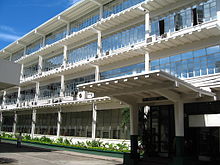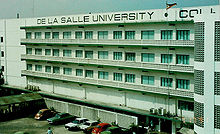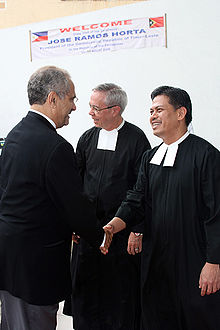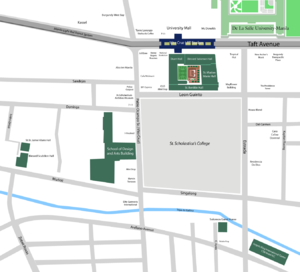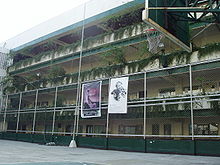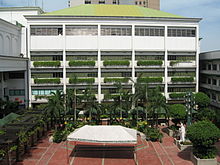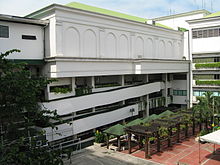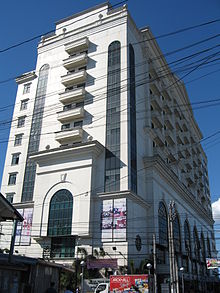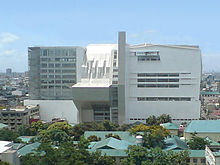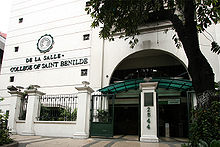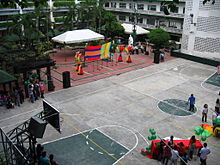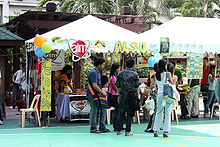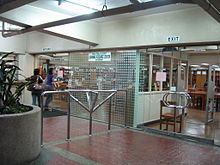- De La Salle
-
De La Salle-College of Saint Benilde 
Established 1988 Type Private Religious affiliation Roman Catholic, Lasallian Chancellor Br. Victor Franco FSC President Br. Victor Franco FSC Admin. staff 1,262[1] Students 8,618[1] (2008) Location 2544 Taft Avenue Malate, Manila, Philippines Campus - Taft Campus: 6,380 m²
- AKIC Campus: 2,100 m²
- SDA Campus: 4,560 m²
Hymn Alma Mater Hymn
Hymn to Saint BenildeColors Sports NCAA, WNCAA, Shakey's V-League Nickname  Blazers
BlazersAffiliations De La Salle Philippines Website www.dls-csb.edu.ph De La Salle-College of Saint Benilde (DLS-CSB or Benilde) is a private Catholic college in the Malate district of Manila, Philippines. The main campus is along Taft Avenue, with two campuses along Pablo Ocampo Street and Arellano Avenue. The college is a member institution of De La Salle Philippines, a network of 17 schools under the De La Salle Brothers Philippine District.
The college was established in 1980 during the administration of Br. Andrew Gonzalez FSC as the College of Career Development, a night school for working students at De La Salle University. In 1988, it was renamed as the De La Salle University-College of Saint Benilde, after Saint Bénilde Romançon, a Christian Brother who taught in France during the 19th century. In 1994, the college became autonomous, and in 2004, along with a restated vision and mission, was renamed to its present name, dropping the University and became De La Salle-College of Saint Benilde.
The college uses learner-centered instruction to offer degree and non-degree programs designed for the development of professionals in the arts, design, management, service industries, computer applications in business, and special fields in study. The college is the first in the Philippines to offer degrees in animation, consular and diplomatic affairs, digital filmmaking, export management, fashion design and merchandising, multimedia arts, music production, photography and information technology major in game design and development.[2][3]
The college's sports teams, known as the Blazers, compete in the National Collegiate Athletic Association with La Salle Green Hills representing the junior division. Since joining the league in 1998, the college has won three general championships, first in the 2005 season and back-to-back in the 2007 and 2008 seasons.
Contents
History
Early history (1980–1987)
In 1980, De La Salle University opened an academic unit known as the College of Career Development, an evening school for working students. In 1984, the Preparatory Studies Department (PSD) was established to allow students to cope with the requirements in subsequent degree-oriented courses in regular undergraduate colleges.[4] In 1985, the college was renamed the Community College. In May 1987, the PSD was phased out and replaced by the Arts and Business Studies Area (ABSA). The ABSA offered two courses: a Bachelor of Arts degree in Management with emphasis on Human Resources Management and a Bachelor of Science degree in Business Administration, major in Computer Applications.
Under De La Salle University (1988–1994)
The Community College was officially renamed De La Salle University-College of Saint Benilde in 1988, after the establishment of the De La Salle University System. Saint Bénilde Romançon was selected as the namesake to symbolize its objective of providing innovative education for the verbally but not numerically gifted, late bloomers, handicapped, as well as artists. Bénilde made room for his students in Clermont-Ferrand, regardless of their age or their mental capabilities. He also learnt sign language to instruct a deaf-mute boy for his first Holy Communion.[5]
The ABSA was renamed as the Arts and Business Studies Department (ABSD) and became the day program of the college, while the Career Development Department (CDD) remained as the college's evening program. Because of the need for more space, the college moved to its own campus at 2544 Taft Avenue in 1989. A third major program, a Bachelor of Arts degree in Interdisciplinary Studies was offered, undertaken in consortium with the College of Liberal Arts. In 1991, the college offered certificate programs in Accounting and Bookkeeping for the Deaf, and a Bachelor of Science degree in Industrial Design.[1]
As an autonomous college (1994–2005)
Presidents of
De La Salle-College of Saint BenildeUnder De La Salle University-Manila • Br. Andrew Gonzalez FSC, 1978-1991 • Br. Rafael Donato FSC, 1991-1994 Under the De La Salle University System • Br. Andrew Gonzalez FSC, 1994-1998 • Br. Rolando Dizon FSC , 1998-2003 • Dr. Carmelita Quebengco, 2003-2004 • Br. Armin Luistro FSC, 2004-2006 Independent administration • Br. Edmundo Fernandez FSC, 2006-2007 • Br. Victor Franco FSC, 2007-incumbent The College of Saint Benilde became an autonomous member of the De La Salle University System in April 1994. The college ratified its proposed Constitution and By Laws, and identified Benildean core values in November 1994.[2] The Night College, a scholarship program, was transferred from De La Salle University-Manila to the college in 1995.[4] In the same year, the School of Design and Arts (SDA) was established, and the following degrees were offered: Bachelor of Science in Interior Design in consortium with the Philippine School of Interior Design, Bachelor of Arts, Major in Production Design, Bachelor of Arts, Major in Technical Theater, Bachelor of Arts, Major in Arts Management, and Bachelor of Performing Arts, Major in Dance.
In 1996, the School of Hotel, Restaurant, and Institution Management was formed, and groundbreaking ceremonies for the Angelo King International Center building were held. The following degrees were first offered in the same year: Bachelor of Science in Business Administration, Major in Export Management; Bachelor of Science in Hotel, Restaurant and Institution Management; Bachelor of Arts, Major in Fashion Design and Merchandising; Bachelor of Arts, Major in Consular and Diplomatic Affairs, and the Bachelor of Arts in Applied Deaf Studies. The college also established the Certificate Program Center (CPC) which offered short courses, and the Grants-in-Aid Program to provide financial assistance to students in need.[1]
In 1997, the administration of the vocational programs of the Night College of the De La Salle University was passed on to the college in June and was renamed as the Blessed Arnould Study Assistance Program in September.[4] In October 1997, the college held its first graduation rites independent from De La Salle University. It was also in this year that the college established the School of Special Studies for deaf students. In March 1998, the NCAA accepted the college's application for membership to the sports league along with La Salle Green Hills athletes as its high school representatives. In 1999, the School of Design and Arts offered the Bachelor of Arts in Multimedia Arts degree, the first of its kind in the country. Later that year, the construction of the Angelo King International Center was completed, which then housed the School of Hotel, Restaurant, and Institution Management.
In 2000, the college won its first Mens Basketball championship title in the NCAA, marking the fastest win of any new school in the league since World War II. The college offered a BSBA degree in Information Management, and a Bachelor of Arts in Music Production degree, a first of its kind. In the same year, the college held bidding for the architect of the proposed School of Design and Arts building.[6] In 2001, the School of Special Studies was renamed as the School of Deaf Education and Applied Studies (SDEAS). A year later, the SDEAS was invited to become a member of the Post-Secondary Education Network-International.[1]
In 2004, the non-university members of the DLSU System — Canlubang, and Health Sciences Campus — removed the term "University" from their names.[2] The college then restated its mission and vision and was renamed De La Salle-College of Saint Benilde.[2] Construction for the 14-storey School of Design and Arts campus was started in this year.[7] The Certificate Program Center was expanded and renamed into the School of Professional and Continuing Education. In 2005, the college became over-all champions for the first time in NCAA Season 81.
Recent history (2006–present)
In 2006, the college became a district school of De La Salle Philippines, the successor of the DLSU System. Br. Edmundo Fernandez FSC, Brother Visitor of the De La Salle Brothers Philippine District, became the college's interim president.[8] The college became the host for the NCAA Season 82,[9] and landed in second place for the General Championship rankings.
In 2007, the School of Design and Arts opened four new degree programs: the Bachelor of Arts degrees in Animation, Digital Filmmaking, and Photography, the first of their kind in the country and Architecture[10] That same year, the new 14-storey School of Design and Arts Campus opened in May in time for the start of school year 2007-2008.[11] The college inaugurated its first Brother President, Br. Victor Franco FSC in September.[12]
In 2008, The School of Management and Information Technology (SMIT), in partnership with the School of Design and Arts, announced intention to offer a new degree on game design and development, pending approval of the Commission on Higher Education.[13] At the end of NCAA Season 83, the college again became the overall champions, winning their second title after two years.[14]
On August 12, 2008, East Timor President, José Ramos-Horta visited the college and gave a talk entitled United in Faith, Partners in Nation-Building held at the School of Design and Arts Campus during a four-day state visit to the Philippines, which marked the first time that a foreign head of state visited the college.[15]
In 2009, the college opened three new degree programs, the Bachelor of Science in International Hospitality Management for SHRIM, which partnered with Vatel International Hospitality School in France, Bachelor of Science in Information Technology, Major in Game Design and Development for SMIT, the first IT program anchored in game design and development in the Philippines, and Bachelor of Science in Architecture for the SDA.[16] The college won its third championship title in the NCAA, and became back-to-back general champions for NCAA Season 84.[17]
Campuses
The college has three campuses: the Taft Campus, the Angelo King International Center, and the School of Design and Arts, all in Malate, Manila. The Taft Campus is a block from De La Salle University, beside St. Scholastica's College and the Vito Cruz LRT Station. The college is surrounded by dormitories, condominiums, and restaurants. To travel between campuses, students may either walk or ride cycle rickshaws stationed near the campuses or the electric jeepney shuttle service provided by the college.
Other properties include the Blessed Hilario Hall on Dominga Street which functions as the college's retreat house. Beside it is the Blessed Scubilion Hall, a residence for student athletes. The Solomon Guest House on C. Ayala Street is a restaurant and meeting area used as a hands-on workplace for selected SHRIM students where they handle the operation of the establishment.
Taft Campus
The Taft Campus stands on a 6,380 square meter lot that stretches from Taft Avenue to the next parallel street, Leon Guinto. The land was acquired from LBP Leasing Corporation, a subsidiary of the Land Bank of the Philippines. The campus is a square made up of four interconnected buildings, the St. Benilde Hall, Duerr Hall, Blessed Solomon Hall, and the St. Mutien Marie Hall. The Duerr Hall has a different alignment with the rest of the buildings, requiring the need for stairs and a ramp on its intersections with the Blessed Solomon Hall.
The Plaza Villarosa, named after architect Rogelio Villarosa, is on the second level of the Taft Campus. It is decorated by lush plants and palm trees, has a basketball court, an elevated platform, and several cabañas with stone benches. The plaza is used as a study area and venue for events and activities in the campus, such as those of the student organizations. Bazaars and food establishments also temporarily set up stalls in the plaza during such events. The statue of Saint Benilde, originally located on the campus's old front gate, was moved to the plaza after its completion. Behind the statue is an 18-bell carillon, built as a memorial to the Lasallian brothers who were massacred in De La Salle College during World War II. The names of the brothers are inscribed on the bells of the carillon. The carillon and the statue, when taken together, stand as the visual representation of the college.[18]
St. Benilde Hall
The first building of the college, named after Saint Bénilde Romançon, was opened on August 11, 1989. It is located at the back of the campus and was designed by Gines Rivera. The building has four storeys, holding numerous lecture rooms and computer laboratories, cafeteria, clinic, and the office of the Information Technology Center. It also houses the offices of the School of Deaf Education and Applied Studies and the School of Management and Information Technology. The Student Grants Unit and the Center for Counseling Services can be found near the Backdoor Gate of the building.
Duerr Hall
Br. Crescentius Richard Duerr FSC, president of De La Salle University from 1961–1966, was a visionary teacher and administrator of La Salle schools in Manila, Bacolod and Iligan City, doing missionary work for 31 years before returning to New York. He was instrumental in the transformation of De La Salle University-Manila in becoming a pillar of Philippine education.
The second building of the campus, originally called "South Wing" because of its location at the southern side of the campus, was blessed on August 10, 1992 and cost 30 million pesos.[19] It houses the Accounting Office, Faculty and Administrative offices of the School of Multidisciplinary Studies, several offices of the programs of the School of Management and Information Technology, and laboratories of the School of Deaf Education and Applied Studies. It has several classrooms and computer laboratories, and an auditorium. It also has a badminton court located on the fifth floor. The on-campus bookstore is located on the first level of the hall near the Career and Placement Office. The Duerr Hall formerly held the Multimedia and Fashion Design laboratories of the School of Design and Arts, prior to the completion of the SDA campus.
The Chapel of the Resurrection is located on the second floor intersection of the Duerr and Solomon Hall. It features glass doors, stenciled drawing of the praying hands, a sacristy and confessional room, and an altar showing Napoleon Abueva's "Lord of the Resurrection."[20]
St. Mutien Marie Hall
Saint Mutien Marie Wiaux was a devoutly religious Brother who made a tremendous influence on the students under his charge through his patience and piety. He taught in Malonne for 58 years, teaching music and arts alongside Catholic dogma. He was canonized in 1989.
Construction of the third and fourth wings of the campus was approved by the Board of Trustees on January 6, 1993.[21] Groundbreaking ceremonies were made on March 1994, while actual construction began on April 16 of the same year.[22] The Mutien Marie Hall and the Blessed Solomon Hall were blessed at October 29, 1996. Both buildings were designed by Architect Rogelio Villarosa and construction cost 120 million pesos.[22]
The General Administrative Services Office occupy the first floor while the Br. Fidelis Leddy Learning Resource Center occupies the whole second level of the building. The third floor up to the fifth consists of lecture rooms. There is also a case room for thesis defense located on the third floor. The gymnasium is located on the topmost level of the building. Most of the classrooms in this building are equipped with LCD and OHP projectors, television sets with VHS players, and computers. The Mutien-Marie Hall formerly held the drafting rooms, Industrial Design laboratory and the head office of the School of Design and Arts.
Blessed Solomon Hall
Blessed Solomon Leclerq was martyred in 1792 after refusing to swear an oath that forced the French clergy of the time to support the state. Before that, he was a teacher, director, and bursar, known for his love for people and for his work. He was beatified in 1926, the first Lasallian brother to be given that honor.
The main entrance of the campus is located at the first level of the Blessed Solomon Hall facing Taft Avenue. The Admissions Office and the Office of Student Behavior can be found at the ground floor, and near the vehicle entrance is the waiting lounge, popularly known as The Airport because the fixed seats resemble an airport departure lounge. The Office of the Registrar as well as other Executive offices are housed in the second level of the building while the Office of Student Affairs, Office of Culture and Arts, Social Action Office, Sports Development Office, Student Publications Office, and the Student Involvement Office are all located on the third level. On the fourth level is the Center for Learning and Performance Assessment, and a dance room and multipurpose room for Physical education classes. On the top level of the Solomon Hall is the Augusto-Rosario Gonzalez Theater, named after the parents of the late Br. Andrew Gonzalez FSC.
Angelo King International Center
The Angelo King International Center (AKIC or the CSB Hotel-International Conference Center) is a fully operational four-star hotel on a 2,100-square-meter lot at the corner of Estrada Street and Arellano Avenue, two blocks from the main campus. It was envisioned to be the first operational hotel-school in the Philippines, where students will be able to experience learning in a real world environment.[23] Groundbreaking rites for the building were in 1996 but actual construction began in 1998 and was finished a year after; it was formally opened in August. It was named after Dr. Angelo King, who gave financial assistance to the construction of the building.
Sharing the space at the building is the CSB Hotel, which has 46 guest rooms and five dormitory type rooms, a conference hall, fine dining restaurant and lobby lounge, cafeteria, library, transport services office, rooftop restaurant, parking space for 126 vehicles, and two service elevators. The first, second, eleventh and twelfth floors are used by the CSB Hotel, and the third to fifth floors are for interior parking while the SHRIM occupies the fifth to ninth floors.
The School of Hotel, Restaurant and Institution Management occupies four floors with 14 air-conditioned classrooms, a tiered demonstration kitchen, demonstration bar, institutional hot, cold and baking/pastry kitchens with adequate cold and dry storage areas, two basic food laboratories, two computer laboratories, a nutrition laboratory, conference rooms, a clinic, and a chapel. The School of HRIM is served by two passenger elevators and one service elevator.[23] Occupying the roof deck is Vatel Restaurant Manila, a fine dining restaurant operated by selected SHRIM students.[24]
Near the AKIC building is the Solomon Guest House, which is operated by selected SHRIM students, where they are involved from marketing to meal preparation and service. The SGH also has three rooms and a suite which could be used as venues for private meetings and gatherings.[8]
School of Design and Arts Campus
The School of Design and Arts Campus (SDA Campus) is a 14-storey academic complex with 55,121.95 m²[11] of usable floor space designed by Lor Calma Design and Associates, with Eduardo Calma as the design principal. It was built on a 4,560 m² lot that was formerly used as parking space for the college, located at 950 Pablo Ocampo Street, and about 500 meters away from the Taft Campus. It was originally planned to open in January 2006, but due to construction delays, the opening was moved to May 2007. It is the third, largest, and most advanced campus of the college which houses its largest and busiest school, the School of Design and Arts. While the exact budget for the building is classified, an estimated amount of 1.2 billion pesos was said to be alloted for the whole building project.[25][26]
The building was dubbed by then De La Salle University System president, Br. Armin Luistro FSC as the "jewel in the crown of the De La Salle University System schools,"[27] as well as one of De La Salle's most ambitious projects.[26] The building features an architectural design never been used before,[26] with a sophisticated façade and all-glass backside and designed where only the tenth floor upwards is visible.[28] Calma relates that the building will feature louvers which, when illuminated at night, will appear like lanterns and considering the location, the lighting effects would set the building apart from its surroundings.[26]
The opening date of the building was moved to September 2006 when the January 2006 opening could not be achieved,[25] but due to construction delays again, a September opening was not possible and the administration hoped for a May 2007 opening instead.[29] The building was delayed due to the intricacy of the architectural design, implementation of the complicated plans, and other problems encountered with the Project Manager and the Contractor. The architectural plans presented design issues which made it difficult to implement plans at a steady rate and construction management encountered conflicts in approach and principles of the onsite technical team.[29] The construction however, gained a steady pace after October 2006 and was completed and inaugurated on April 2007.
The building has four floors of above-level parking space and ten floors of workspace served by two service and five passenger elevators and five sets of stairs. It features a Building Management System with intelligent controls for air conditioning; smoke detection and fire alarms; CCTV surveillance security systems; and has its own sewage management plant.[11] The building is also fully Wi-Fi enabled and the first building in the Philippines to be equipped with 10-G Technology.[11] Among of its notable facilities include a 3-storey, 558-seater[11] theater which is cantilevered four storeys above the ground and the Museum of Contemporary Art and Design, a 520 square meter contemporary art museum which was envisioned to be the first of its kind in the Philippines.[26] On the inside, it has spacious corridors that can double as exhibition spaces. Every classroom air-conditioned and configured for better acoustics. The building also has a cafeteria, a chapel, and a two-floor library in addition to lecture, computer, and seminar rooms. There are also video, animation, and sound production laboratories as well as a photography studio and a greenscreen TV and film production studio with motion capture equipment, and a 105-seater cinema.[11]
Academics
The college uses Howard Gardner's theory of multiple intelligences, where each person is said to possess varying levels of the different intelligences which determine his or her cognitive profile. The theory is implemented through learner-centered instruction where classes are taught according to the student's understanding of the subject and recognizes the uniqueness of each learner.[30][31] Learner-centered also refers to a learning environment that pays attention to the knowledge, skills, attitudes, and beliefs that learners bring to the educational setting.[32]
The college has six schools which offers degree and non-degree programs designed for the development of professionals in the arts, design, management, service industries, computer applications in business, and special fields in study.
School of Deaf Education and Applied Studies
The School of Deaf Education and Applied Studies (SDEAS) was first established in 1991 as a vocational program offering courses in accounting and bookkeeping for the Deaf. The vocational program became the School of Special Studies with the addition of the Bachelor in Applied Deaf Studies (BAPDST) degree five years later. The school was restructured and renamed as the School of Deaf Education and Applied Studies in 2000. The BAPDST course was refined and began offering specialization tracks in Multimedia Arts and Business Entrepreneurship. The SDEAS is one of only six institutions in the Philippines that offer postsecondary education to the deaf.[33]
In 2001, the SDEAS partnered with the Postsecondary Education Network-International, a global partnership of colleges and universities funded by the Nippon Foundation of Japan that aims to provide deaf students the appropriate postsecondary education for them to achieve their full potentials. Two learning centers were established since the partnership: The PEN-Multimedia Learning Center (2003) and the PEN-Learning Center (2006), both at Duerr Hall.[33]
School of Design and Arts
The School of Design and Arts (SDA) was established in 1995 and is one of the largest schools of the college with its thirteen degree program offerings and a student population of about 2,000.[31] It has approximately 145 faculty members per trimester and 90 percent are part-timers because they are also active industry practitioners at the same time.[31] The SDA seeks to develop the creative and business skills of students adept in the arts. Because of the increasing number of students, a new building was constructed to accommodate the growing student population.
The SDA offers Bachelor of Arts degrees in Animation, Arts Management, Digital Filmmaking, Multimedia Arts, Music Production, Photography, Production Design, Technical Theater, and Fashion Design & Merchandising; Bachelor of Science degrees in Architecture, Industrial Design and Interior Design; and a Bachelor of Performing Arts degree in Dance.[31][34] Two of its programs are offered in consortium with other schools and organizations, the Interior Design program with the Philippine School of Interior Design and the Dance program with the Ballet Philippines Dance School of the Cultural Center of the Philippines.[34]
The Multimedia Arts and Technical Theater degrees are the first of their kind in the Philippines.[34][35] The Technical Theater program teaches the technical aspects of production in stage, film and television. It also provides in-depth coverage on the applications of various technical equipment used in set production, while the Multimedia Arts program incorporates various art forms with the latest in multimedia technology. Areas of study include graphic design, photography, 2D and 3D animation, web design and development, and video production. It is also one of the three most popular SDA programs, along with Fashion Design and Merchandising and Industrial Design.[31]
School of Hotel, Restaurant and Institution Management
The School of Hotel, Restaurant and Institution Management (SHRIM) was established in 1996 and aims to provide the hotel and restaurant industry with graduates who possess the requisite knowledge, skills, knowledge and values to become successful entrepreneurs and to train students to become "industry-ready" for hotel and restaurants in the country and abroad.[23] It offers the Bachelor of Science degree in Hotel, Restaurant and Institution Management which integrates theory and practice to provide students with a strong management and service orientation as well as a global perspective of hotel and restaurant operations. It has three tracks, the Culinary Arts track, Hospitality Management track, and Tourism Management track.[36]
The school is housed at the Angelo King International Center, a four-star hotel-school at the corner of Arellano Avenue and Estrada Street. Students are given their first on-the-job training at the CSB Hotel which is housed at the center. Students are deployed at either of its subsidiaries: the Solomon Guest House, a restaurant and lodge fully student-managed and operated,[37] and the Chefs' Station, a food stall at the cafeterias of the college.[38]
In 2009, the SHRIM partnered with the Vatel International Hospitality School of Paris. With this educational cooperation, the school is concurrently known as Vatel Manila and is included in the Vatel international network. Under the Vatel partnership, the school offers the Bachelor of Science in International Hospitality Management.[39]
School of Management and Information Technology
The School of Management and Information Technology (SMIT) offers degrees based on business and information technology disciplines.[40] It offers Bachelor of Science in Business Administration (BSBA) degrees majoring in Computer Applications, Export Management, Human Resource Management and Bachelor of Science degrees in Information Systems, and Information Technology majoring in Game Design and Development.[16] The SMIT continues the college's Career Development Program by offering BSBA degrees in Business Management and Marketing Management as night programs for working students.[40]
In 2005, the SMIT, along with the SHRIM, was given accreditation by the Philippine Accrediting Association of Schools, Colleges and Universities.[8] In 2009, the SMIT partnered with the Singapore-based online graduate school Universitas 21 Global. Part of the agreement includes an elective in Electronic Business for the Computer Applications and Information Systems programs. Students enrolled in the elective will have access to Universitas 21 Global's resources, and will be trained by its staff.[41]
School of Multidisciplinary Studies
The School of Multidisciplinary Studies (SMS) handles the general education curriculum of all programs offered by the college. It provides the students a strong foundation in the languages, social and natural sciences, theology and philosophy. While the SMS is one of the largest schools of the college,[42] it only has one program offering, the Bachelor of Arts in Consular and Diplomatic Affairs (CDA) degree. The CDA program aims to develop practitioners in international relations.
School of Professional and Continuing Education
The School of Professional and Continuing Education (SPaCE) provides post-baccalaureate diploma programs for graduates seeking continuing education in various business-related fields. Formerly held by the SMIT, the SPaCE now handles the Career Development Program (CDP) which offers BSBA degrees in Business Management and Marketing Management. The Career Development Program gives adult students the opportunity to gain a degree program while at work through a streamline program and format which caters to their busy lifestyle.
Student life
The college uses the trimestral calendar, where the school year usually begins in the last week of May. Freshmen students are required to attend the freshmen orientation program of the Department of Student Life, which is held a week before the start of classes. Freshmen students are oriented by upperclassmen about the school's policies, the facilities of the campus as well as what to expect during their stay in the college. In June, the Student Involvement Unit organizes the STAR Week (STudent Activities Recruitment Week), when the student organizations can recruit new members from the freshmen. The College Week is held during August, where the feast day of Saint Benilde is celebrated through various activities and several masses. Every Wednesday and Friday, a vacant period given from 12:40 p.m to 2:20 p.m., known as C-Break (College Break), can be used by organizations to hold seminars and workshops, training period for the performing groups, or to hold special events and activities. The Plaza Villarosa is usually used for activities, where the basketball court can be used for training sessions or sports activities, the performing stage for concerts, and the cabañas for bazaars.
Student government
The De La Salle-College of Saint Benilde Student Council (DLS-CSB Student Council), headed by President Glennn Aster Carrillo, is the highest, sole, unified, autonomous, responsive, and democratic governing student representative of the College, the power and authority of which emanates from the Student Body. It recognizes the importance of the College’s Mission-Vision Statement and this serves as its guide. The prime concern of the DLS-CSB Student Council is to promote, protect, and advance the students’ rights and welfare.
The DLS-CSB Student Council is composed of 23 officers and all enrolled students as members. It is categorized into the Executive Board (EB), The School Representatives, and the Frosh Representatives. The EB is composed of 8 officers namely the President, Vice President for Academics and Concerns, Vice President for Internal Affairs, Vice President for External Affairs, Executive Secretary, Finance Officer, Auditor, and the Public Relations Officer (P.R.O), all of which are elected by entire student body. The School Representatives are composed of 10 officers, whereas each of the 5 schools (SDEAS, SHRIM, SMS, SDA, SMIT) has 2 Representatives, all of which are elected only by the students of their respective schools. The Frosh Representatives are composed of 5 officers, whereas each school (SDEAS, SHRIM, SMS, SDA, SMIT) has 1 Frosh Representative, all of which are elected only by the freshmen students of their respective schools.
Student organizations
The college has organizations under the Student Involvement Office of the Department of Student Life. All recognized student organizations are members of the Council of Presidents, the mother organization which overlooks operations and project handling.
Professional organizations caters to a specific degree program. There are sixteen professional organizations which include the:
- Association of Information Management (AIM) is the professional organization that protects, uplits, and promotes the Information Management program of the College. It establishes lkages with other social organizations and key departments of the College, as well as other outside organizations.
- Association of Music Production Students (AMPS) is an organization that is dedicated to fostering growth of musical aptitude and the appreciation of all types of music among the students of Music Production Program.
- Computer Business Association (CBA) is the renowned information technology and business student organization that promotes excellence among its members.
- Corps of Diplomats (COP) is a professional organization that seeks to advance the intellectual capabilities of its members by coming up with projects that will increase their knowledge on diplomatic etiquette and protocol.
- Export Management Society (EMS) is a professional organization that aims to develop future exporters and entrepreneurs who are Filipino in Ideals, professionally competent, and world class.
- Game Developers Union for Innovation and Leadership Development (GUILD)
- Human Resource Management Society (HRMS)
- Hoteliers in Progress (HIP)
- Industrial Design Society (IDS)
- Junior Marketing Association (JMA)
- Media Max (MMX)
- Students Collaborating and Reaching Out in Events and Arts Management (SCREAM)
- Travelers in Progress (TRIP)
- Vateliens in Progress (VIP)
Special Interest organizations cater to non-academic and special interests. There are twelve special interest organization which include:
- Computer Link(COMLINK) is a special interest organization that is steadfast in creating opportunities that seek to develop professionally competent Benildeans in the field of Information Technology by organizing student-centered programs and projects.
- Coro San Benildo is the resident chorale group of De La Salle - College of Saint Benilde.
- Debate Society (DebSoc)
- Dulaang Filipino (DF)
- Greenergy (GNY)
- International Student Association (ISA) is a special interest organization of De La Salle - College of Saint Benilde that aims to promote intercultural awareness, understanding and apprehensive association between the Foreign and Filipino students.
- Kino Eye (KE)
- Optic View (OV) is a special interest organization that aim to share knowledge about our skills as well as to help to develop and nurture the skills of other photographer hobbyist. We unite under one goal and that is to capture breath taking moments as close as possible to reality itself.
- Silent Steps
- Societe Et' Cultura (SEC)
- Stage Production and Operations Team (SPOT)
- St. Benilde Romancon Dance Company (SBRDC) is the resident dance company of the De La Salle - College of Saint Benilde.
An electoral body (student government body)- DLS-CSB Commission on Elections (COMELEC)
Varsity organizations include the:
- Pep Squad
- Fencing Team
- Samahang Kali Arnis ng Benilde
- Women's Football Team
Students may also opt to join in the five volunteer groups directly tied to an office under the Department of Student Life. These include volunteers and student trainers for the:
- Student Involvement Unit
- Social Action Volunteers for the Center for Social Action
- Student Ministers for the Center for Lasallian Ministry
- Kaagapay for the Center for Counseling Services.
Student publications
Through the Student Publications Office, the college caters to the student's interests.
- The Benildean is the official student newspaper. It provides a voice for the thoughts, concerns and opinions of the students. It is released once a month every trimester.
- BLiP (Benildean Lifestyle, Interests and People) is the official features magazine of the college, which showcases the life and interests of Benildeans. First published in 2004, it tackles fashion, travel, and other topics.
- Karilyon is a magazine discussing Filipino lifestyles and issues. It aims to promote Filipino culture, language and ideals. It is published only in the Filipino language.
- Shades of Gray is a literary folio that showcases the literary talents of students. It is published once a year.
- Ablaze is a sports magazine released twice a year that provides an in-depth look into the personalities and perspectives behind Benildean sports and its athletes.
- Horizons is a design folio that trains students adept in the visual arts. It presents representations and images that are sometimes serious, sometimes light-hearted, but always thought provoking.
- Dekunstrukt is a photo folio that showcases the works of students skilled in photography. It provides a venue for the college's student photographers to express and present their view of the people and the world around them.
- Ad Astra is the annual yearbook. It was first published as the Benildean Yearbook in 2000. Students are encouraged to subscribe to it one year before their graduation. The yearbook is bundled with an interactive CD version and a graduation photo package.
Athletics
Main article: St. Benilde Blazers
In 1998, the NCAA accepted the college's application for membership into the league. The St. Benilde Blazers represents the senior team and the La Salle Green Hills Greenies represent the junior team, while the Lady Blazers represent the college in the WNCAA. The first NCAA seniors basketball title of the Blazers in 2000 was the fastest for an expansion squad. The college won its first senior General Championships title in the 81st Season, while the LSGH Greenies landed on second place. The college hosted the 82nd Season with the theme "Proud and True at 82: Blazing Beyond Limits".
Learning Resource Center
The Br. Fidelis Leddy Learning Resource Center (LRC) is the multimedia resource center and library of the college. It provides access to conventional printed materials, such as books and periodicals, and other forms of storage media, such as transparencies, videotapes, compact discs, and other electronic/digital materials. The LRC's audio-visual equipment can be borrowed. The LRC has facilities on each campus. Each facility has separate audio-visual and reading areas.
Members of the De La Salle Brothers' community, De La Salle University-Manila alumni, as well as students and employees of De La Salle Philippines member schools are authorized to use the LRC. Non-Lasallian users can be given access as long as they have recommendation or referral letters from their respective librarians.[43]
The LRC was first located at the Benilde Hall in a three-classroom setup. It housed a small collection of books and some audio-visual equipment. After the completion of the Mutien-Marie Hall in 1996, the LRC was moved to its present location on the second floor of the new building. It was named as the Br. Fidelis Leddy Learning Resource Center, in honor of the longest living Lasallian Brother in the Philippines at that time, Br. Leander Fidelis Leddy FSC celebrated his 50 years of service in the country and his 60th year as a Lasallian Brother that year.[43]
Facilities
Taft Campus
At the Taft Campus, the LRC is divided into two areas: the LRC-Main occupying the second floor of the St. Mutien-Marie Hall, up the stairway from the main entrance, and the LRC-Extension located underneath the Plaza Villarosa, which was formerly used as parking space. The LRC-Main holds the audio-visual equipment and multimedia resource collections, periodicals, as well as the memorabilia and thesis collections of the college. It has an audio-video listening and viewing area for the LRC's VHS collection. The LRC-Extension is an additional reading area where students can browse, borrow, and bring home books from the LRC's general book collections except for the Lasalliana collection which is for room use only.
AKIC Campus
The LRC in the AKIC Campus provides the learning resource needs of the School of HRIM, holding book collections and relevant periodicals for its students and faculty. The reading area can be found on the sixth floor of the AKIC campus. It has a floor area of 224 square meters, and a seating capacity of 100.[43] The Audio-Visual Service Section can be found on the seventh floor, and has a floor area of 105 square meters.[43][43]
SDA Campus
The LRC in the SDA Campus occupies a part of the seventh and eighth floors of the building, housing the LRC's design and art book collection.
Collections
As of summer 2006, the LRC has a total collection of about 80,000 book titles (90,000 volumes), 4,657 volumes of undergraduate theses, more than 1,000 periodical titles (in print, electronic and microfilm formats), 139 titles of transparency-based library materials, more than 4,013 CD-ROM volumes, more than 2,562 commercial VHS tapes, 113 slide titles, 253 maps, 594 audio cassette tapes, 159 VCD titles, 107 DVD titles, 440 volumes of audio CDs, 7 titles of selected newspapers in microfilm format, and 5,000 volumes of in-house VHS tapes on campus activities.
Books found at the LRC-Extension and LRC-AKIC are grouped by collection: Reference, Reference Filipiniana, Filipiniana and General Collection. Each book is arranged by the Library of Congress Classification System. The LRC follows the revised Anglo-American Cataloging Rules 2 and the LC Classification System for cataloguing and classifying books. The LRC and its extensions have Online Public Access Catalog stations for quick searching of books needed by the students.
The college subscribes to several online databases and electronic journals. Among them are ProQuest 5000 International, Thomson Gale, Global Market Information Database, Ovid PsycArticles Full Text Journals, Emerald Database, and the Journal of Deaf Studies and Deaf Education. The database and journals can be accessed from computer units within the campus or at home through the online library facility at the college website.
References
- ^ a b c d e 50302520 Philippine Lasallian FaMiLi. Volume 10, Issue 3. November–December 2008
- ^ a b c d College History. dls-csb.edu.ph. Retrieved January 2009.
- ^ About the College dls-csb.edu.ph. Retrieved October 18, 2006.
- ^ a b c DLSU-College of Saint Benilde Interactive. Development and Communications Office. 2003
- ^ CSB'S Original Vision, excerpts from the paper of Br. Andrew Gonzalez FSC. DLSU-CSB Newsletter. August 10, 1992
- ^ Shrine to cutting-edge creativity Philippine Daily Inquirer, October 24, 2007
- ^ A design student’s utopia The Manila Times August 12, 2007
- ^ a b c 18 to 1 La Salle Perspective. Volume 8 no. 1. May 29, 2006
- ^ Let the games begin Perspective. Volume 8 no. 4. June 19, 2006
- ^ SDA unveils three new courses Perspective. Volume 8 no. 29-30. January 15–28, 2007
- ^ a b c d e f Worth the Wait Perspective. Volume 8 no. 41. April 9–15, 2007
- ^ The Anointed ONE Perspective. Volume 9 no. 8. October 1–14, 2007
- ^ Game time Perspective. Volume 9 no. 15. January 28-February 10, 2008
- ^ Sweet Smell of Success Perspective. Volume 9 no. 18. March 10–23, 2008
- ^ Timor-Leste President visits DLS-CSB Perspective. Volume 10 no. 5. August 25-September 7, 2008
- ^ a b Benilde Offers Three New Degree Programs. Perspective. Volume 10 no. 10. March 6-April 5, 2009
- ^ St. Benilde retains NCAA general championship Theodore P. Jurado. People's Journal. March 02, 2009
- ^ Fresh Perspective. Marketing Communications Office. 2005
- ^ 5 It is a reverse L shaped structure and features a service ramp and an façade with lush overhanging foliage. At present, ddministrative offices now occupy its first two floors. DLSU-CSB Newsletter. January 28, 1992
- ^ The college community witnesses the blessing of the Chapel of the Resurrection. DLSU-CSB Newsletter. February 1, 1993
- ^ BOT Approves 2 major proposals on college expansion. DLSU-CSB Newsletter. January 18, 1993
- ^ a b The Heat is on-New structures in place. DLSU-CSB Newsletter. March–April 1994
- ^ a b c The School of Hotel, Restaurant & Institution Management. DLSU-CSB Newsletter. June–August 1996
- ^ Vatel Restaurant Manila. The Philippine Star. March 23, 2010. Accessed April 17, 2010
- ^ a b SDA transfer delayed. The Benildean. April 2006
- ^ a b c d e Making a bold statement with design, arts building, Philippine Daily Inquirer, July 13, 2005
- ^ Best of Benilde 2005: Special edition Perspective. Marketing Communications Office. 2005
- ^ Push the limits of design possibilities. Perspective. June 20, 2005
- ^ a b SDA Building Update. Br. Edmundo Fernandez FSC. October 2006
- ^ The Benildean Frosh Issue 2006. pg.4
- ^ a b c d e Fostering Creativity in Schools and Colleges. Gerard L.V. Torres. Retrieved November 24, 2006.
- ^ How People Learn: Brain, Mind, Experience, and School. John D. Bransford, Ann L. Brown, and Rodney R. Cocking. Retrieved December 6, 2006.
- ^ a b SDEAS: 15 Years. Perspective. September 11, 2006
- ^ a b c SDA Degree Programs. dls-csb.edu.ph. Retrieved February 23, 2010.
- ^ Changing the face of education. Manila Bulletin. May 19, 2004. Retrieved November 24, 2006.
- ^ SHRIM Degree Programs www.dls-csb.edu.ph
- ^ Other Propertieswww.dls-csb.edu.ph
- ^ SHRIM Edu-Caters!. Perspective. Volume 8 no.23-24. Nov. 13-26, 2006
- ^ Vatel Manila. Retrieved February 28, 2009.
- ^ a b SMIT Degree Programs www.dls-csb.edu.ph Retrieved February 24, 2010.
- ^ SMIT Partners with U21Global Perspective. Volume 11 no. 1. June 1-June 30, 2009.
- ^ No shortage of teachers in SMS - Saldivar. The Benildean. June–July 2006.
- ^ a b c d e Br. Fidelis Leddy Learning Resource Center Handbook. DLS-CSB LRC and MCO. 2006
External links
De La Salle Philippines Metro Manila De La Salle Araneta University • De La Salle Santiago Zobel School • De La Salle University • De La Salle – College of Saint Benilde • La Salle Green HillsLuzon De La Salle Canlubang • De La Salle Health Sciences Institute • De La Salle Lipa • De La Salle University – Dasmariñas • Jaime Hilario Integrated School – La Salle • La Salle College AntipoloVisayas De La Salle Andres Soriano Memorial College • St. Joseph School – La Salle • University of St. La SalleMindanao Affiliations De La Salle Supervised Schools • De La Salle Brothers National Collegiate Athletic Association (2011–12)
National Collegiate Athletic Association (2011–12) 
ArellanoChiefs LetranKnights DLS-CSBBlazers EACGenerals JRUHeavy Bombers LyceumPirates MapúaCardinals San BedaRed Lions San SebastianGolden Stags UPHSDAltas High SchoolBraves High SchoolSquires La Salle
Green HillsGreeniesEAC–ICABrigadiers High SchoolLight Bombers Lyceum
Cavite
Baby PiratesMalayanRed Robins Rizal Campus
High SchoolRed CubsHigh SchoolGolden Staglets Business
High SchoolAltalettesBadminton | Basketball | Beach volleyball | Cheerleading | Chess | Football | Lawn tennis | Soft Tennis | Softball | Swimming | Table tennis | Taekwondo | Track and field | Volleyball | GeneralRelated: Letran – San Beda rivalry | Battle of IntramurosSee also: NCAA South | Arellano and EAC are currently members under probation; Lyceum is a guest member. University Belt Universities Adamson University · Arellano University · Centro Escolar University · De La Salle University · EARIST · Far Eastern University · FEATI University · Manuel L. Quezon University · National University · Universidad de Manila · University of the East · University of Manila · Pontifical and Royal University of Santo Tomás · Philippine Christian University · Philippine Normal University · Philippine Women's University · Polytechnic University of the Philippines · Technological University of the Philippines · University of the Philippines ManilaColleges College of the Holy Spirit · De La Salle-College of Saint Benilde · La Consolacion College Manila · University of Perpetual Help, Manila · Philippine College of Health Sciences, Inc. · National Teachers College · PMI Colleges · San Beda College · San Sebastian College – Recoletos · Philippine School of Business Administration · Santa Catalina College · Technological Institute of the PhilippinesCoordinates: 14°33′49.50″N 120°59′42.64″E / 14.56375°N 120.9951778°E
Categories:- South Manila Inter-Institutional Consortium
- De La Salle Philippines
- Educational institutions established in 1988
- Art schools in the Philippines
- Film schools in the Philippines
- Cooking schools
- Design schools
- Hospitality schools
- Schools for the deaf in the Philippines
- Schools of international relations
- Schools of the performing arts
- Educational institutions in Manila
- National Collegiate Athletic Association (Philippines)
- Schools in the Philippines
- Special schools in the Philippines
Wikimedia Foundation. 2010.

